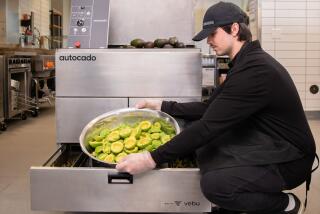What’s With Long Lines? Check It Out Yourself
- Share via
The future is waiting for you at a grocery store beneath the Hollywood sign. It’s a self-checkout system, a computerized cashier that lets you scan your own groceries, pay your bill, collect your coupons and sprint out the door.
All this is designed to limit the amount of time you spend waiting in line and reduce expenses for grocery stores, which theoretically translates into lower grocery prices in much the same way that automated teller machines have brought down bank fees. Oh, wait. Never mind.
Based on the time I spent watching consumers using the system at the Food 4 Less on Sunset Boulevard, there’s a learning curve involved here. But I do think it’s possible that some consumers will prefer this type of arrangement.
Apparently, the more you use it, the easier things get. One shopper said he uses the computer checkout all the time. Why? “It’s a lot faster than that,” he said, waving toward a dozen lines of people waiting to interact with a flesh-and-blood cashier.
If you use the system often enough, maybe that’s true. Though I confess that I’m a bit worried about what this means for life in the future.
See, I spent a chunk of my life as the night manager at a 7-Eleven store. It was decent money, I didn’t have to battle the elements, and the job didn’t require a lot of credentials--the key requirement for me, as I had none at the time.
I wonder how the world is going to work for young people who don’t have a lot of job experience when there’s really no such thing as entry-level labor.
The self-checkout system has been sold by an Ottawa company called Optimal Robotics Corp. since 1995. There are nearly 4,000 terminals in use in about 1,000 stores in 42 states; similar systems are sold by other companies, but Optimal has about 75% of the market.
The cost of the systems varies wildly from location to location. The price is usually set so that the retailer should see a return on the investment within the year. That money comes in the form of labor savings and increased throughput. Four of the things can fit in the space usually filled by a single lane helmed by one cashier.
The systems are usually set up in blocks of four, and they’re not completely human-free.
One cashier monitors a station near the four checkouts, helping people do things such as scan the produce properly, guarding against theft and answering questions.
Consumers clearly have a lot of questions when using the checkouts. One older man finally lost it, waving a head of cauliflower about and bellowing, “Well, I’m not using this anymore!”
Most other users I studied stumbled often but seemed game.
The systems use a standard scanner. Run your items over the window and the system beeps and tells you to place it in a bag.
Placing the item in the bag is a critical part of the operation. The bags--paper or plastic--rest on a large carousel-type arrangement pretty much capable of holding the contents of an entire grocery cart. The carousel is hooked up to weight sensors and has a database that tells the system what each product scanned should weigh. If the weight doesn’t match the item, the system knows there’s a mistake someplace. For instance, you might be trying to steal something by placing two items in the bag but scanning only one.
The system also has a video camera that seems pretty sophisticated. It spotted the bunch of bananas I placed on the scanner--which doubles as a scale--and provided the proper code to be punched into the system so that it could weigh the fruit and charge accordingly. The image on the camera also shows up at the little podium where the cashier got visual feeds and system updates from all four of the systems. If there was trouble--which there frequently was--the cashier would zip over and resolve the issue.
The system has a lot of appeal for me, since I hate waiting behind people who apparently don’t have lives. The guy who pays his grocery bill by counting out change and the lady who doesn’t even begin looking for her wallet until she learns what the bill is can boost my blood pressure. At such moments I could easily be the poster child for gun control.
I’m generally a big fan of automation. I love bank machines. But I’d hate to live in a world where there were no tellers at all.
It seems increasingly likely that humans will mostly be doing high-end tasks, with the grunt work relegated to machines. Which sounds great, unless you’re at a place in life where you’re not yet qualified to do high-end tasks.
I wonder if eventually our robots will become so sophisticated that they’ll just refuse to do some jobs. Maybe someday that will be the only kind of work available to people who lack the right credentials.
*
Inside
Dave Wilson answers reader questions in Tech Q&A.; T8
More to Read
Inside the business of entertainment
The Wide Shot brings you news, analysis and insights on everything from streaming wars to production — and what it all means for the future.
You may occasionally receive promotional content from the Los Angeles Times.









